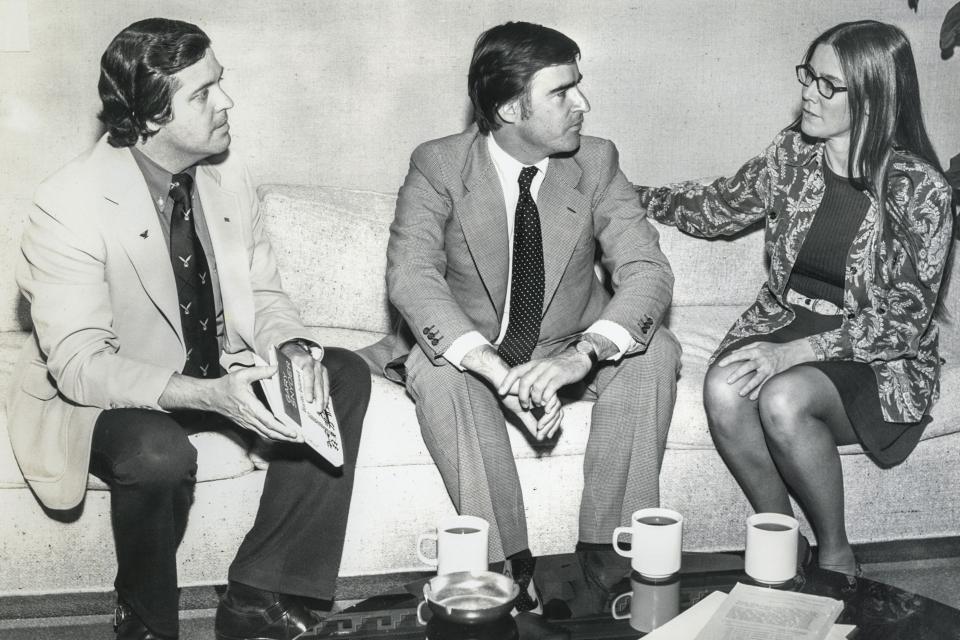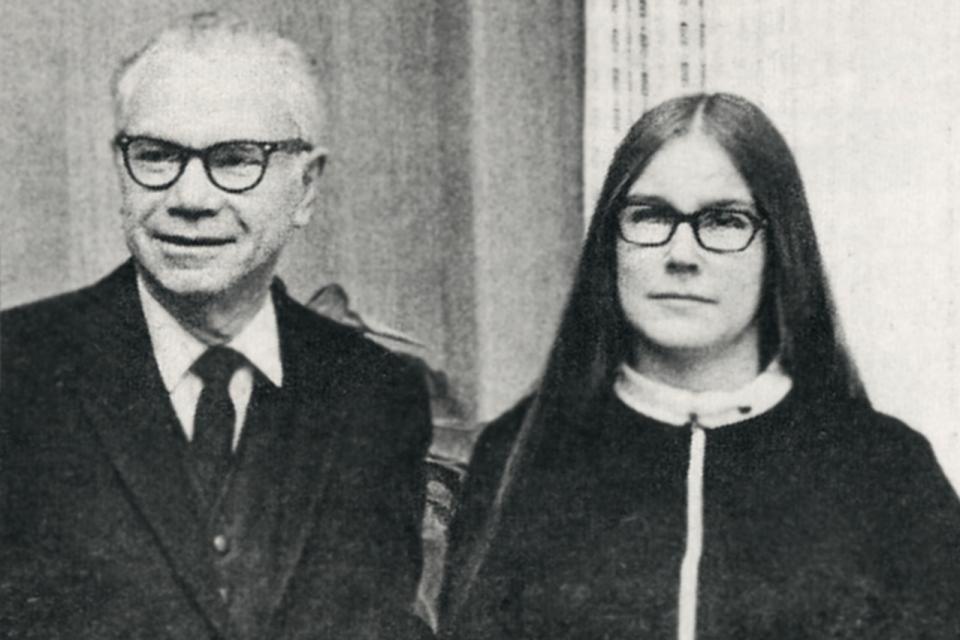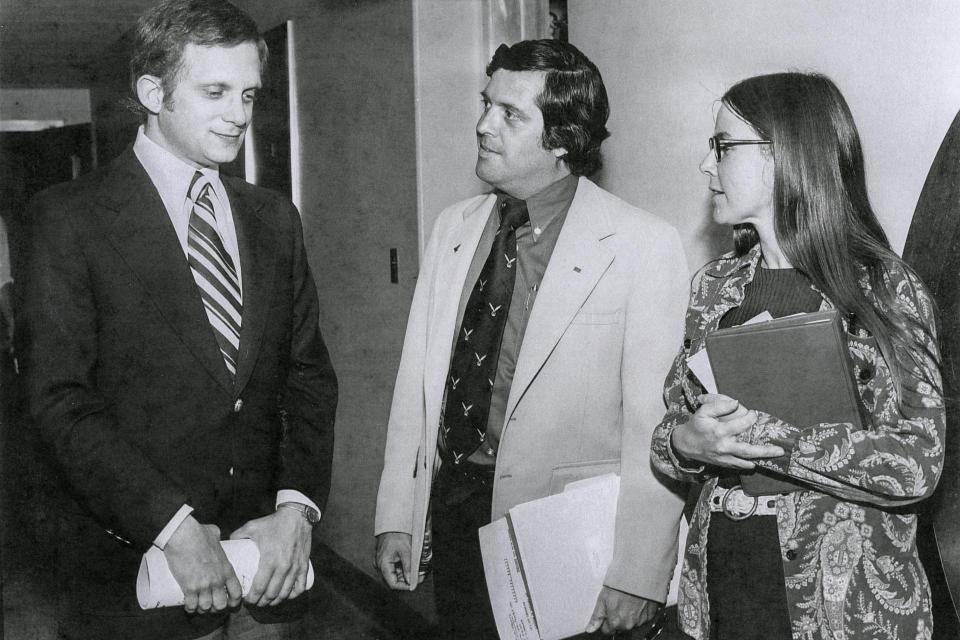Editor’s note: This memoir was originally published as “30 Years Looking Back” in August 1999 by the Institute of Industrial Relations in CPER, A Periodical of Employee Relations in the Public Sector.
By Mary Bergan
I begin with Robert Reich’s admonition that a memoir is not a history. It chronicles events as the writer remembers them. This is a memoir.
I started to lobby for the California Federation of Teachers in January 1972. Ronald Reagan was governor and the state Senate was controlled by the Republicans. The year before was the first time that our union and the California Teachers Association had been pushed into an uneasy alliance – mostly by our mutual affiliate United Teachers Los Angeles – to attempt to secure passage of collective bargaining legislation.
Going into the 1972 legislative session (the Legislature had one-year sessions then), we came together to fashion a bill that would become a major part of our respective legislative programs. Assemblyman Ken Meade agreed to author the bill and CTA brought in UC Davis Professor Don Wollett to act as a consultant on what should be in the bill. Once again, however, Assemblymen Leroy Greene and Leo Ryan, both difficult men, set unreasonable conditions for their votes, and the bill never got beyond the Assembly Education Committee.
For many years, the California Labor Federation – the state AFL-CIO had, at our request, introduced a simple bill putting educational employees under the Labor Code to extend private sector bargaining rights to the education community. It was imperfectly drafted, which few seemed to note since the bill’s prospects were clouded at best. In 1972, the bill was carried by Senator Mervyn Dymally and was assigned to the Senate Education Committee, chaired by the respected Al Rodda. Despite the fact that Rodda had been president of the Sacramento Federation of Teachers, AFT Local 31, in his high school teaching days, he had yet to vote for a collective bargaining bill for teachers. My goal for 1972 was to get Senator Rodda’s vote, and if things really went well, to move the bill out of the committee, which had a Republican majority.
As a teacher, the senator had been party to a union-backed suit challenging a school district’s right to assign teachers any way they chose, especially to non-teaching duties. (As a personal example, he told with some passion of being expected to hold back hordes of enthusiastic students at the end of an emotion-packed football game – an impossible job.) The failure of the suit and Rodda’s own anger at how teachers were treated by school administration led him to believe that there should be a contractual arrangement between teachers and school administration to temper this rather absolute authority. I wanted him to act on that belief with a vote.
Deadlines then were not what they are now, so I was able to get the Dymally bill set for its first hearing late in the session, in June, just after school was out. The day of the hearing, the large Senate hearing room was full of teachers, most of whom had, during the previous weeks, contacted committee members urging their support of the bill. Senator Dymally, who had done a bit of organizing for the AFT along the way, made a good presentation that we bolstered with carefully selected horror stories of dreams denied by unenlightened school management.
But the real drama came with the vote. The chairman’s name was called last, and, indeed, Senator Rodda gave us the fifth aye vote, one short of a majority, but two more than we’d ever gotten before. I was a happy person. Then, the secretary again called the names of those who had not voted. Senator Don Grunsky, a Republican from the central coast, had been catching up on his correspondence during the hearing. He uttered a distracted aye vote. We couldn’t believe our good fortune. But the senator, aroused no doubt by the audible gasp from all assembled, quickly became cognizant of his action and reversed it. Sigh.
Nonetheless, those five votes were the high point of my first year as a lobbyist. I knew when that it was only a matter of time – a short time – before we would secure collective bargaining.
Waiting for a new governor
The fall elections gave the Democrats majorities in both houses of the Legislature. In 1973, the collective “we” of CFT, CTA, and UTLA turned to Senator George Moscone, by then the Democratic majority leader of the Senate and arguably the most able legislator in either house. Bill Lambert of UTLA convinced Republican Assemblyman Bill Bagley to co-author the legislation in the hopes that he might eventually secure a signature from Governor Reagan.
Putting SB 400 on the governor’s desk was an adventure. Issues that were raised during its journey through the Legislature set the stage for what eventually became law. University of California students formed their lobbying effort around this time, and they wanted a seat at the table. Agency fee had been included from the beginning, and opposition from the Seventh Day Adventists led to the exemption for bona fide religious beliefs. The PTA wanted to know what was going on, so we got a “sunshine” clause. Boalt Hall Professor David Feller appeared on the scene to give his reasons that UC senate faculty weren’t workers like everyone else. We had to demonstrate to the state legislative analyst that salary raises and other negotiated items were not state-mandated costs.
All along, Assemblyman Bagley was optimistic he could get Ronald Reagan to sign SB 400 if we would make certain concessions. In the end, however, Senator Moscone thought the concessions were too much. No one was surprised when the bill was vetoed.
The new year brought a new session and a new bill. But the effort was a minor one that year; we knew we’d have to wait for a new governor.
The new governor was Jerry Brown. Early in his first year of office, attempts were made to forge a single collective bargaining law for all public employees. Perhaps we were all our own worst enemies as we tried to reconcile the differing views of our own constituencies about how the process should work for them. We often met along into the night, the governor trying his best to bring unions and management together, but it was a doomed enterprise.
In the meantime, Senator Rodda was approached by school board members in his Sacramento area district who were convinced that collective bargaining was inevitable but who were concerned about what it would bring. The senator assigned Education Committee consultant John Bukey to craft a bill that could get as broad a consensus in the education community as possible. The committee held hearings on collective bargaining to draw on the experience of those who had had bargaining experience elsewhere, and John spent day upon day drawing up a bill that the unions and, perhaps, management could support, or at least live with. In the end, SB 160 covered employees in the K-12 and community college districts, both of which were governed by local boards. The bill had a limited scope of negotiations and was signed into law in 1975 as the Educational Employment Relations Act.
Howard Berman wrestled University of California and California State University unions into agreement two years later to bring bargaining to those segments through the Higher Education Employer-Employee Relations Act. Units could be university wide or campus based. Senate units, if any, would have to be separate from others.
Representation and bargaining
In scores of school districts across the state, CTA gained voluntary recognition by submitting membership lists. Where the AFT/CFT was a force, we prepared for representation elections. The first one, on May 20, 1976, was in the Tamalpais High School District in Marin County, and it gave the AFT a narrow victory. A few years later, teachers there decided they should give CTA a chance to show what it could do. After two more switchovers, CTA today holds the bargaining rights, and the organizations have operated for several years as a merged entity at the local level.
All CFT staff, along with reinforcements from AFT, worked elections. One of my first was in the Newport-Mesa district in Orange County. Going door to door to talk to teacher voters about AFT, I got a quick lesson in Southern California geography, as well as in the concerns and fears of teachers, especially those just beginning their careers in this growing area. We lost that election but came back to secure bargaining rights for the local AFT three years later. Since that first election, I never again have subjected myself to witnessing a vote count.
In the community colleges, the issue of appropriate units needed to be addressed. In the Los Rios district in Sacramento, we petitioned for a unit comprising both full- and part-time faculty, and other non-management academic employees. This was challenged by college administration or CTA, or both. In any event, the new Educational Employment Relations Board finally issued a precedent-setting ruling establishing the all-inclusive unit as the most appropriate in the colleges. That did not prevent units of full-timers only from being established at some colleges because that was what the union petitioned for. Part-timers were not being represented in those places. In recent years, most part-timers have gained access to the bargaining table either as members of overall units or as separate units.
It took a while for many in school and community college administration to come to terms with bargaining. Some saw it as a threat to their power, which it is. Others who had opposed its enactment simply tried to behave as if it would soon go away. Few had experience in bargaining beyond the old “ meet and defer.” As it became clear that collective bargaining was — is — here to stay, both sides have learned to use the process and reach accommodation, at least in most places.
From the beginning, bargaining over money was difficult. It is important to remember that the basic funding of school districts was changed in 1972 when SB 90 established revenue limits, which effectively deprived districts of the rising property taxes of the latter part of the decade. (This also had added excitement to my first legislative year, as CFT was the only education organization to oppose SB 90, which was held up in the Senate for months by Senators Moscone and Rodda and 12 of their wiser colleagues.) Like-minded legislation, SB 6, imposed a similar system on community colleges the following year. When Proposition 13 came along in 1978, it just made a bad funding situation worse. Community college funding in particular again underwent major changes that, among other things, locked in the underfunding of non-credit programs and the overuse of part-time faculty. This made it difficult for urban districts to recoup the losses of enrollment and revenues suffered with the first-ever imposition of tuition.
Proposition 98 in 1988 gave schools and community colleges some protection as state revenues dipped; but Proposition 111, the following year, established spending caps and reduced state revenues to education when overall state revenues declined, as they did throughout the early 1990s.
One result of the funding laws was to make it more difficult for management to hide money from unions at the bargaining table. Unions also have developed their own school and college financial expertise. But, in the end, there’s no getting away from the fact that California education is funded well below the national average, and there just isn’t enough money to do all the things districts are required to do.
Underfunding and administrative turnover also have made it difficult to maintain interest-based bargaining, which many districts and unions have turned to in recent years.
At the University of California and the California State University, bargaining has been a much more difficult process. The law really doesn’t provide as level a playing field as was intended, especially in view of the universities’ penchant for imposing, rather than negotiating, what they call “settlements.”
Because AFT/CFT represents lecturers and librarians at UC, I am more familiar with how things have gone there. It has been clear from the beginning that UC takes it as an affront that its employees feel the need to unionize, and has fought unionization even while going through the motions of negotiations. Whereas practically every school and community college employer has remained neutral in representation elections, UC waged campaigns for “no representation” like those found in the private sector. In some cases this backfired, as many employees receiving campaign mail from the university (finding folks was more difficult for the unions than it is now) were notified for the first time that there was an election and that they would have the opportunity to vote for union representation.
Union staff members report that negotiations with UC are like no other, that it is unclear who actually makes decisions for the university, so that those who come to the table adopt a “take it or leave it” mode. Nonetheless, there has been an upsurge in organizing at UC by activist unions, and we have sponsored legislation to strengthen HEERA’s impasse procedures and encourage real give-and-take at the table. President Atkinson has said he wants to improve UC’s labor relations, but I fear that even if he makes sincere efforts in that direction, he too will have to battle through the bureaucrats to get a clear picture of who has been calling the shots and how to bring about real change.
Final thoughts
Collective bargaining is not a process set in stone. Since its enactment it has been a vehicle for improving the working conditions for faculty and classified employees in California education. Scope has been stretched when parties at the table have found it to their mutual advantage. Trust agreements have supplemented contracts in some places to deal with things arguably not in scope or to launch what might be considered pilot programs. As members ask for help with their professional lives, it is likely that contracts will change in terms of what they address and how. Like democracy, collective bargaining may not be a perfect process and is definitely prone to human foible, but’ I’m proud of the role that the California Federation of Teachers and I as the union’s agent have played in bringing it to those who work in California education.
About the author as published in 1999
Mary Bergan is president of the California Federation of Teachers and has worked for that organization and for the American Federation of Teachers for nearly three decades. After a stint with the Peace Corps in Malaysia, Bergan returned to California and served as a local AFT president. She next accepted a staff position with CFT as a field organizer and went on to became CFT’s first full-time lobbyist in Sacramento – a position she held for 19 years. In addition to her post as CFT President, Bergan was elected a vice president of the AFT at its 1992 national convention.



